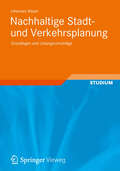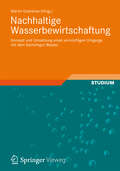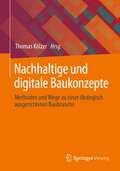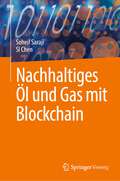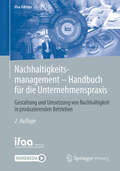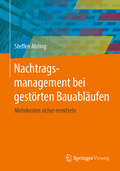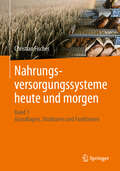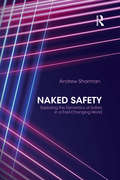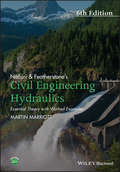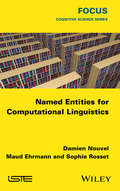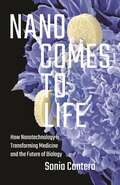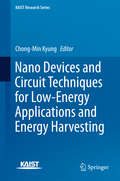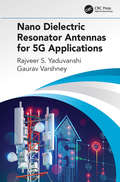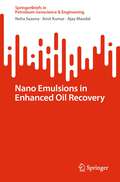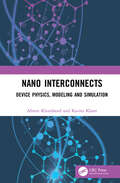- Table View
- List View
Nachhaltige Stadt- und Verkehrsplanung
by Johannes MeyerAusgehend von den Grundlagen des Städtebaus beschäftigt sich dieses Buch mit dem besonderen Aspekt der Nachhaltigkeit in der aktuellen Stadt- und Verkehrsentwicklung und dem Umgang mit bestehenden städtebaulichen Strukturen. Die Themen Demographischer Wandel, Energieeinsparung, Umwelt- und Klimaschutz stehen dabei im Fokus. Es enthält sowohl grundlegende Informationen als Einstieg in die Thematik als auch konkrete Beispiele aus der Praxis.
Nachhaltige Wasserbewirtschaftung
by Martin Wahl Michael Becker Martin Grambow Jacobus Hofstede Alois Heissenhuber Andreas Goetz Anton Steiner Bernd Scherer Christiane Groß Christine Krämer Christine Wenzel Claus Kumutat Dietmar Wienholdt Erich Eichenseer Erich Englmann Gabriele Merz Gregor Overhoff Hans Huber Holger Magel Ingo Reimann Jakob Opperer Karl Schneider Katrin Horn Maria Patek Martin Faulstich Martin Steger Michael Haug Peter Rutschmann Peter Wilderer Raoul Weiler Reinhard F. Schmidtke Rolf Manser Stephan Von Keitz Theo Schlaffer Ulrich Drost Walter Binder Werner Reifenhäuser Werner Wahliß Wolfgang Günthert Wolfram MauserDer Wassersektor gehört zu den ganz großen aktuellen globalen Herausforderungen. Wasserbewirtschaftung verlangt ein vertieftes Verständnis der Nachhaltigkeit. Das Buch erläutert vor diesem Hintergrund Theorie und Praxis des integrierten Managements. Es erklärt politische und technische Grundlagen des Wassermanagements und entwirft einen praxisnahen modularen Lösungsansatz, der eine erfolgreiche Bewirtschaftung des Wasserschatzes erleichtert.
Nachhaltige betriebliche Wasserwirtschaft: Konzept des Prozesswasserkreislaufs inklusive Energie- und Wertstoffrückgewinnung
by Rolf StiefelDarstellung der sich verschärfenden Anforderung hinsichtlich Wassergewinnung, höhere Anforderung bei der Abwassereinleitung sowie der Preisdruck bei Energie- und Rohstoffen. Lösungsmöglichkeiten für Industriebetriebe durch wassersparende Produktion, Abwasserrecycling, Rohstoffrückgewinnung, Regenwassernutzung und energieeinsparung.
Nachhaltige und digitale Baukonzepte: Methoden und Wege zu einer ökologisch ausgerichteten Baubranche
by Thomas KölzerIn Anbetracht der Auswirkungen des Klimawandels auf unsere Umwelt müssenbestehende Prozesse in vielen Bereichen unserer Gesellschaft überdacht werden.Damit einhergehend ist es wichtig, innovative und vor allem auch ökologische Konzeptevermehrt in den Fokus zu rücken. Da die Baubranche einen massiven Anteilan den negativen Effekten auf unsere Umwelt hat, liegt es nahe, erfolgsversprechendeAnsätze genau in diesem Bereich ausfindig zu machen. Mithilfe digitaler Konzeptesind verschiedene Zusammenhänge so modifizierbar, dass Abläufe nicht nureffektiver, sondern insbesondere auch nachhaltiger werden. So stellt sich im Hinblickauf die anstehenden Herausforderungen infolge des Klimawandels die Frage,welche zusätzlichen Potenziale sich durch innovative Herangehensweisen ergeben.Das vorliegende Sammelwerk präsentiert diesbezüglich aktuelle und zukunftsweisendeKonzepte aus verschiedenen Bereichen der Baubranche.
Nachhaltiges Qualitätsdatenmanagement: Bericht zur GQW-Jahrestagung 2022 in Chemnitz
by Sophie GrögerDie Gesellschaft für Qualitätswissenschaften e. V. verfolgt seit Ihrer Gründung im Jahre 1994 das Ziel, Qualitätswissenschaft in Lehre und Forschung zu fördern und den Wissenstransfer in die industrielle Anwendung zu unterstützen. Hierzu werden im Rahmen der Jahrestagungen die aktuellen Ergebnisse aus Forschung und Entwicklung vorgestellt und zukünftige Trends in diesem Bereich thematisiert und diskutiert. Die GQW Jahrestagung 2022 fand unter Leitung von Prof. Dr.-Ing. habil. Sophie Gröger in Chemnitz statt. Unter dem Leitthema „Nachhaltiges Qualitätsdatenmanagement“ wurden zahlreiche Beiträge aus Forschung und Industrie vorgestellt. Diese thematisierten dabei beispielsweise die Integration des ISO GPS-Systems in kleine und mittelständische Unternehmen (KMU), eine Vorgehensweise zur fertigungsprozessorientierten Prüfplanung, aber auch die Verknüpfung von Messdaten und Datenbanken zur Vergleichbarkeit von Messergebnissen. Ebenso wurden die Anwendung von Methoden des maschinellen Lernens und die intelligente Qualitätssicherung durch Bildverarbeitung vorgestellt. Es konnte aufgezeigt werden, wie mit der Verknüpfung von Daten im Bereich der Problemlösung eine Verbesserung aktueller Ansätze (8D-Report) erreicht werden kann. Ein Reifegradmodell zur Bewertung der Datenqualität in Industrie 4.0 und eine Informationsbedarfsanalyse für Verbesserungen im Fehlermanagement in der manuellen Montage ergänzten das Tagungsprogramm. Nicht zuletzt wurden neue digitale Möglichkeiten zum Kompetenznachweis sowohl in der Agrar- und Ernährungswirtschaft als auch im Automotive Bereich diskutiert. Freuen Sie sich also auf ein inhaltlich breites Spektrum interessanter Beiträge aus Forschung und Industrie im Bereich der Qualitätswissenschaften.
Nachhaltiges Öl und Gas mit Blockchain
by Si Chen Soheil SarajiIn dieser Monografie wird das Potenzial der Blockchain-Technologie zur Erleichterung des Übergangs in der Öl- und Gasindustrie untersucht.Während sich die Welt auf eine nachhaltige Energiezukunft zubewegt, steht die Öl- und Gasindustrie vor großen Herausforderungen und Chancen. Das Buch konzentriert sich auf die Entwicklung einer nachhaltigen O&G-Industrie und befasst sich mit der Rolle des Klimas und der Finanzmärkte im Energiesektor, den Anwendungen von Blockchain in der nachhaltigen Energieentwicklung und den Herausforderungen rechtlicher und regulatorischer Fragen bei der Anwendung der Blockchain-Technologie. Es gibt einen Einblick, wie die Energiebranche bereits an der Reduzierung von Kohlenstoffemissionen arbeitet und den Weg in eine nachhaltige Zukunft ebnet, mit detaillierten Beispielen für die Reduzierung von Methanemissionen, Kohlenstoffkreditmärkten, nachhaltigen Flugzeugtreibstoffen und Kunststoffen.Das Buch untersucht auch, wie O&G-Unternehmen ihre Nachhaltigkeitsinitiativen mit Hilfe der Blockchain-Technologie für die Überwachung von Emissionsdaten, die Kohlenstoffabscheidung, -nutzung und -speicherung sowie das Lieferkettenmanagement zur Entwicklung sauberer Produkte vorantreiben können.
Nachhaltigkeit in der Lehre: Eine Herausforderung für Hochschulen (Umweltbildung, Umweltkommunikation Und Nachhaltigkeit / Environmental Education, Communication And Sustainability Ser. #19)
by Walter Leal FilhoDieses Buch richtet sich an alle, die das Thema Nachhaltigkeit in der Lehre behandeln möchten. Es trägt zum Erfahrungs- und Informationsaustausch zwischen Lehrenden und Wissenschaftlern bei, und stellt erfolgreiche Ansätze vor, wie das Thema Nachhaltigkeit in der Lehre vermittelt werden kann. An zahlreichen Hochschulen gibt es bereits interessante und attraktive Lehrangebote zu Nachhaltigkeit. Dabei sollte es nicht nur um die Vermittlung von Sachwissen gehen. Nachhaltigkeit in der Lehre beinhaltet, dass sowohl Wissen als auch pragmatische Handlungskompetenzen bei den Studierenden durch inter-, trans- und multidisziplinäre Ansätze gefördert werden. Gerade jetzt, da die Staaten weltweit anstreben, die UN Nachhaltigkeitsziele umzusetzen, ist es dringend erforderlich, dass Nachhaltigkeit in der Lehre durch eine Kombination von Theorie und Praxis eingeführt wird. Hier setzt diese Buch an und zeigt neue Wege auf, wie das Thema Nachhaltigkeit ganzheitlich in der Lehre vermittelt werden kann.
Nachhaltigkeit und Social Media: Bildung für eine nachhaltige Entwicklung in der digitalen Welt
by Annika Bush Jonas BirkeDas Konzept der Nachhaltigkeit erfährt in den letzten Jahren zunehmend Aufmerksamkeit in allen Lebensbereichen. Ob es um Stories zum Klimaschutz auf Instagram, Erklärvideos zur Kreislaufwirtschaft auf YouTube oder Tweets zur Armutsbekämpfung auf Twitter geht - längst hat das Thema auch Einzug in die aufmerksamkeitsstarke Welt von Social Media gefunden. Diese bieten bisher nie dagewesene Möglichkeiten der digitalen Vernetzung und des informellen Lernens. Dadurch rücken sie Nachhaltigkeit verstärkt aus der wissenschaftlichen Nische in den öffentlichen Diskurs.Dieser Sammelband verbindet die bisher zumeist getrennt gedachten Bereiche Nachhaltigkeit und Social Media. Welche nachhaltigen Themen dominieren in den sozialen Netzwerken? Wie werden diese in Facebook rezipiert und auf YouTube diskutiert? Welchen Einfluss hat die Darstellung von ressourcenschonendem Verhalten bei Instagram auf den privaten Alltag? Diesen und weiteren spannenden Fragen wird in diesem Kompendium auf den Grund gegangen. Zwölf innovative Beiträge aus unterschiedlichen Fachdisziplinen untersuchen verschiedene Social Media hinsichtlich der Darstellung und Kommunikation von Nachhaltigkeitsthemen und zeigen, welche Chancen, aber auch welche Herausforderungen sich durch die Verbindung beider Themenkomplexe ergeben. Damit wird ein Beitrag zum wissenschaftlichen und gesellschaftlichen Diskurs beider Bereiche geleistet und die Nachhaltigkeitsforschung im digitalen Raum gestärkt.
Nachhaltigkeit von Produkten zum integralen Innenausbau: Anforderungen und Anwendungen (Entwicklung neuer Ansätze zum nachhaltigen Planen und Bauen)
by Rebekka HaasIntegrale Produkte und Konzepte für den Büroinnenausbau werden auf ihre Nachhaltigkeit betrachtet. Mit Hilfe eines methodischen Vorgehens soll die Frage beantwortet werden, ob die Nachhaltigkeit einer Ausbaufläche durch die integrale Büroflächenkonzipierung beeinflusst wird. Im Zuge dessen wird ein Analysekonzept erarbeitet und anhand einer exemplarischen Fläche angewandt. Es erfolgt die Gegenüberstellung einer konventionellen und einer integralen Ausbauvariante hinsichtlich ausgewählter Nachhaltigkeitsaspekte.
Nachhaltigkeitsmanagement - Handbuch für die Unternehmenspraxis: Gestaltung und Umsetzung von Nachhaltigkeit in kleinen und mittleren Betrieben (ifaa-Edition)
by ifaa – Institut für angewandte Arbeitswissenschaft e. V.Das Handbuch vermittelt in anschaulicher, praxisorientierter Weise Grundlagen, Inhalte und Vorgehensweise bei der Einführung und Verbesserung eines Nachhaltigkeitsmanagements in Unternehmen. Anhand von Beispielen wird einfach und verständlich dargestellt, wie Unternehmen durch die Gestaltung von Produkten, Unternehmensprozessen und Anlagen ihre Leistungsfähigkeit bei Umweltschutz, Wirtschaftlichkeit und Sozialverantwortung verbessern können. Das Handbuch befähigt die betrieblichen Akteure zur erfolgreichen Umsetzung in ihrem Betrieb. Das Handbuch enthält zudem Anregungen für Unternehmen, die integrierte Managementsysteme bspw. für Umwelt, Qualität und Nachhaltigkeit etablieren oder weiterentwickeln möchten.
Nachhaltigkeitsmanagement - Handbuch für die Unternehmenspraxis: Gestaltung und Umsetzung von Nachhaltigkeit in produzierenden Betrieben
by ifaa – Institut für angewandte Arbeitswissenschaft e. V.Das Handbuch vermittelt in kompakter Form die Grundlagen und ein praxisorientiertes Konzept zur erfolgreichen Einführung und Verbesserung eines Nachhaltigkeitsmanagements in Unternehmen. Es basiert auf einem ganzheitlichen Verständnis von Nachhaltigkeit, das neben wirtschaftlichen, umweltbezogenen und sozialen Aspekten auch technische Ziele berücksichtigt. Die Inhalte werden strukturiert, übersichtlich und anschaulich dargestellt. Das Handbuch enthält zudem zahlreiche Hinweise sowie praktische Arbeits- und Gestaltungshilfen für betriebliche Akteure.
Nachtragsmanagement bei gestörten Bauabläufen: Mehrkosten sicher ermitteln
by Steffen AhtingGestörte Bauabläufe sind bei der Durchführung von Bauabläufen längst kein Einzelfall mehr. Um den wirtschaftlichen Erfolg einer Maßnahme dennoch zu sichern und eine verantwortungsgerechte Kostenallokation herzustellen, kann die Seite, welche die Störung nicht zu verantworten hat, berechtigte Mehrkosten zurückfordern oder die Erstattung des entstandenen Schadens von der anderen Partei verlangen. Dieser Leitfaden gibt den am Bau Beteiligten ein entsprechendes Tool an die Hand, die durch Bauablaufstörungen entstehenden Mehrkosten nachvollziehbar und transparent zu berechnen und bietet eine gute Orientierung bei der gesamten Abwicklung von Bauablaufstörungen.
Nahrungsversorgungssysteme heute und morgen: Band 1 - Grundlagen, Strukturen und Funktionen
by Christian FischerWie lassen sich im Jahr 2050 etwa 10 Milliarden Menschen gesund ernähren und nachhaltig mit Nahrungsmittel versorgen? Dieses Buch behandelt in einfachen Worten aber mit der notwendigen inhaltlichen Tiefe einige der dringensten Probleme der Menschheit und diskutiert mögliche Lösungsansätze.Band 1 beschreibt die Grundlagen heutiger Nahrungsvorgungsketten und -systeme („Food Supply Chains and Systems“). Neben Fragen der Ressourcenverfügbarkeit werden alle Stufen der Nahrungsversorgungskette, das heißt die Landwirtschaft und Aquakultur, die Lebensmittelverarbeitung, der Lebensmittelhandel und der Verbrauch in Haushalten und außer Haus behandelt
Naked Lunch
by William S. BurroughsDelirious, nonlinear ravings of a junkie in hell. Also includes excerpts from the Boston trial where it was declared not obscene in 1966.
Naked Safety: Exploring The Dynamics of Safety in a Fast-Changing World
by Andrew SharmanWorkplace safety has never been seen as sexy, clever or cool. Fraught with legislative hurdles, ambiguous policy and complex procedures, despite its alleged importance safety has lost its way. For many organisations safety is seen as burdensome and bureaucratic and has become little more than paperwork and performance charts: things done in fear of persecution – from the authorities, the media or the civil arena – rather than doing the right thing. To change the game and build real risk literacy, it’s vital to make things easier, to strip things back to basics and think again about how we work. This is Naked Safety. Encouraging the reader to step outside their comfort zone, this book demystifies workplace safety, challenging traditional views and catalysing critical thought and high-impact action. With narratives on the central pillars of workplace safety including risk management; legal frameworks; performance; governance; leadership and culture, as well as perspectives on key issues that affect safety – and business – more broadly, such as worker wellbeing; employee engagement; the impact of globalisation; corporate social responsibility; sustainability and the role of the safety practitioner, Naked Safety features over 100 actions to bring about positive, sustainable organisational change. This book is a useful, multi-purpose guide for professionals; an indispensable toolkit for practitioners, business leaders, and anyone with an interest in workplace risk and Occupational Safety and Health. Let’s get Naked!
Nalluri And Featherstone's Civil Engineering Hydraulics
by Martin MarriottAn update of a classic textbook covering a core subject taught on most civil engineering courses. Civil Engineering Hydraulics, 6th edition contains substantial worked example sections with an online solutions manual. This classic text provides a succinct introduction to the theory of civil engineering hydraulics, together with a large number of worked examples and exercise problems. Each chapter contains theory sections and worked examples, followed by a list of recommended reading and references. There are further problems as a useful resource for students to tackle, and exercises to enable students to assess their understanding. The numerical answers to these are at the back of the book, and solutions are available to download from the book?s companion website.
Named Entities for Computational Linguistics
by Damien Nouvel Sophie Rosset Maud EhrmannOne of the challenges brought on by the digital revolution of the recent decades is the mechanism by which information carried by texts can be extracted in order to access its contents. The processing of named entities remains a very active area of research, which plays a central role in natural language processing technologies and their applications. Named entity recognition, a tool used in information extraction tasks, focuses on recognizing small pieces of information in order to extract information on a larger scale. The authors use written text and examples in French and English to present the necessary elements for the readers to familiarize themselves with the main concepts related to named entities and to discover the problems associated with them, as well as the methods available in practice for solving these issues.
Nano Comes to Life: How Nanotechnology Is Transforming Medicine and the Future of Biology
by Sonia ConteraThe nanotechnology revolution that will transform human health and longevityNano Comes to Life opens a window onto the nanoscale—the infinitesimal realm of proteins and DNA where physics and cellular and molecular biology meet—and introduces readers to the rapidly evolving nanotechnologies that are allowing us to manipulate the very building blocks of life. Sonia Contera gives an insider's perspective on this new frontier, revealing how nanotechnology enables a new kind of multidisciplinary science that is poised to give us control over our own biology, our health, and our lives.Drawing on her perspective as one of today's leading researchers in the field, Contera describes the exciting ways in which nanotechnology makes it possible to understand, interact with, and manipulate biology—such as by designing and building artificial structures and even machines at the nanoscale using DNA, proteins, and other biological molecules as materials. In turn, nanotechnology is revolutionizing medicine in ways that will have profound effects on our health and longevity, from nanoscale machines that can target individual cancer cells and deliver drugs more effectively, to nanoantibiotics that can fight resistant bacteria, to the engineering of tissues and organs for research, drug discovery, and transplantation.The future will bring about the continued fusion of nanotechnology with biology, physics, medicine, and cutting-edge fields like robotics and artificial intelligence, ushering us into a new "transmaterial era." As we contemplate the power, advantages, and risks of accessing and manipulating our own biology, Contera offers insight and hope that we may all share in the benefits of this revolutionary research.
Nano Devices and Circuit Techniques for Low-Energy Applications and Energy Harvesting
by Chong-Min KyungThis book describes the development of core technologies to address two of the most challenging issues in research for future IT platform development, namely innovative device design and reduction of energy consumption. Three key devices, the FinFET, the TunnelFET, and the electromechanical nanoswitch are described with extensive details of use for practical applications. Energy issues are also covered in a tutorial fashion from material physics, through device technology, to innovative circuit design. The strength of this book lies in its holistic approach dealing with material trends, state-of-the-art of key devices, new examples of circuits and systems applications. This is the first of three books based on the Integrated Smart Sensors research project, which describe the development of innovative devices, circuits, and system-level enabling technologies. The aim of the project was to develop common platforms on which various devices and sensors can be loaded, and to create systems offering significant improvements in information processing speed, energy usage, and size. The book contains extensive reference lists and with over 200 figures introduces the reader to the general subject in a tutorial style, also addressing the state-of-the-art, allowing it to be used as a guide for starting researchers in these fields.
Nano Dielectric Resonator Antennas for 5G Applications
by Rajveer S. Yaduvanshi Gaurav VarshneyWe are always surrounded by electromagnetic waves and fields of various spectra. This book explains basic electromagnetic theory with the help of design formulations i.e. mathematical background on antennas along with experimentations, which has made this book unique. The main purpose of this book is to embed mathematical EM theory of dielectric resonator antennas with experimental validation so that understanding of concepts takes place. Initially, basic understanding of philosophy of dielectric resonators has been discussed, then it is supported with mathematical modeling and later same is implemented with its prototype model along with experimentations. The modes theory gives important analysis on currents distribution, impedance analysis and radiation pattern in DRA. Circular polarization can built signal robustness, case studies on circular polarization has been included. Equivalent RLC circuit concept has been introduced. Challenges of switching from microwave to terahertz has been briefly discussed. Nano DRA will revolutionize the wireless technology. Nano DRA ,Terahertz DRA and Quantum DRA have analyzed and studied.
Nano Drug Delivery for Cancer Therapy: Principles and Practices
by Firdos Alam KhanThis book discusses the various modes and methods of nano-based drug delivery in different types of cancers such as colon, breast, cervical, ovarian, and lung cancer. It reviews the significance of nano drug delivery in cancer therapy, the application of nanoparticles in overcoming drug resistance, targeted therapy, and immunotherapy. The book also covers topics related to the synthesis of different types, shapes, and sizes of nanocarriers using synthetic and biological approaches. Further, a chapter explores the synthesis of nanocarriers loaded with anti-cancer drugs by using functionalization or conjugations and encapsulation methods. The book also examines the nanocarriers as delivery vehicles for chemotherapeutic agents against cancers using in vitro and animal models of cancers, preclinical trials for efficacy, and safety profiling of nanocarriers. Finally, future trends and innovation in nano drug delivery for cancer therapy, application of siRNA (nanoparticle-based RNA) therapy, ultrasound-linked nano-cancer therapeutics, and application of exosome-based cancer therapy topics are discussed. Towards the end, the book examines the limitations of nanocarriers, including the cell and tissue toxicity, genotoxicity, and scale-up of nanomaterials, health and environmental hazards associated with nanoformulation synthesis, respiratory diseases, government regulations, and ethical issues.
Nano Emulsions in Enhanced Oil Recovery (SpringerBriefs in Petroleum Geoscience & Engineering)
by Amit Kumar Neha Saxena Ajay MandalThis book focuses on the use of nanoemulsion in enhanced oil recovery, along with a brief information about the emulsion and its types and different physico-chemical properties used to analyse the efficiency of the emulsions and nanoemulsions. The author discussed about the nanoemulsion, classification of emulsions and nanoemulsion and use of nanoemulsions in petroleum industry. A special attention has been laid on nanoemulsion and its advantages over commercial product, physico-chemical properties like emulsification, interfacial tension and wettability alteration study as a screening criteria for application in EOR. Given this content, this book offers an assessment for the undergraduate and postgraduate students of petroleum and chemical engineering along with the researchers working in the field of EOR. It is a subject of interest for oil and gas industry professionals.
Nano Enhanced Phase Change Materials: Preparation, Properties and Applications (Materials Horizons: From Nature to Nanomaterials)
by Adarsh Kumar Pandey Zafar SaidThis book provides information on thermal energy storage systems incorporating phase change materials (PCMs) which are widely preferred owing to their immense energy storage capacity. The thermal energy storage (TES) potential of PCMs has been deeply explored for a wide range of applications, including solar/electrothermal energy storage, waste heat storage, and utilization, building energy-saving, and thermal regulations. The inherent shortcomings like leakage during phase transition and poor thermal conductivity hamper their extensive usage. Nevertheless, it has been addressed by their shape stabilization with porous materials and dispersing highly conductive nanoparticles. Nanoparticles suspended in traditional phase change materials enhance the thermal conductivity. The addition of these nanoparticles to the conventional PCM enhances the storage. In this book, the history of Nano Enhanced Phase Change Materials (NEPCM), preparation techniques, properties, theoretical modeling and correlations, and the effect of all these factors on the potential applications such as: solar energy, electronics cooling, heat exchangers, building, battery thermal management, thermal energy storage are discussed in detail. Future challenges and future work scope have been included. The information from this book can enable the readers to come up with novel techniques, resolve existing research limitations, and come up with novel NEPCM, that can be implemented for various applications.
Nano Hydrogels: Physico-Chemical Properties and Recent Advances in Structural Designing (Gels Horizons: From Science to Smart Materials)
by Sabu Thomas Vijay Kumar Thakur Jiya JoseThis book introduces the reader to important aspects of the nano-hydrogels. It covers the development of hydrogels and their biology, chemistry and properties. Focus is also given to innovative characterization techniques and advances in structural design, with special emphasis on molecular structure, dynamic behavior and structural modifications of hydrogels. This book serves as a consolidated reference work for the diverse aspects of hydrogels, creating a valuable resource for students and researchers in academia and industry.
Nano Interconnects: Device Physics, Modeling and Simulation
by Afreen Khursheed Kavita KhareThis textbook comprehensively covers on-chip interconnect dimension and application of carbon nanomaterials for modeling VLSI interconnect and buffer circuits. It provides analysis of ultra-low power high speed nano-interconnects based on different facets such as material modeling, circuit modeling and the adoption of repeater insertion strategies and measurement techniques. It covers important topics including on-chip interconnects, interconnect modeling, electrical impedance modeling of on-chip interconnects, modeling of repeater buffer and variability analysis. Pedagogical features including solved problems and unsolved exercises are interspersed throughout the text for better understanding. Aimed at senior undergraduate and graduate students in the field of electrical engineering, electronics and communications engineering for courses on Advanced VLSI Interconnects/Advanced VLSI Design/VLSI Interconnects/VLSI Design Automation and Techniques, this book: Provides comprehensive coverage of fundamental concepts related to nanotube transistors and interconnects. Discusses properties and performance of practical nanotube devices and related applications. Covers physical and electrical phenomena of carbon nanotubes, as well as applications enabled by this nanotechnology. Discusses the structure, properties, and characteristics of graphene-based on-chip interconnect. Examines interconnect power and interconnect delay issues arising due to downscaling of device size.
